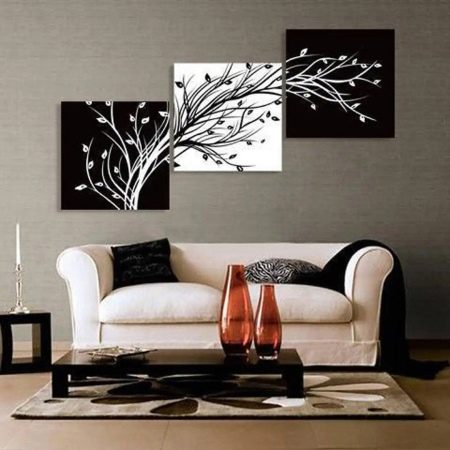What is a triptych and how to hang pictures?

The word "triptych" has probably been heard by people interested in creative fields such as music, sculpture or visual arts. However, for many people, this term remains unknown until they are faced with home decor. In this article we will tell you what a triptych is, how to use it in the design of an apartment and what types of this art direction are.






What it is?
The term "triptych" comes from the ancient Greek language - in translation this word means "consisting of three tablets" or "consisting of three tablets". A triptych can be any creative work, for example, bas-reliefs, sculptures or paintings, the main thing is that all three parts of the work should be united by one common idea. The modular exposition, which consists of three parts, is a kind of polyptych - a trend in art, which is a work of two or more parts, performed in the same theme. As a rule, in a triptych, the central picture is the largest, and the two side ones are small in size and are intended only to complement the plot.
Nevertheless, contemporary art does not have rigid frames, so many art ensembles consist of paintings of the same size or even of three canvases of different sizes.



Dividing pictures into modules is a very interesting and non-standard solution that allows you to take a fresh look at familiar things. Contemplating three images united by one idea, art connoisseurs involuntarily begin to look for common features and differences in them in order to understand why the author decided to divide the work into parts.Usually, ensembles of paintings are much more interesting to people who are fond of creative work than classical paintings on one canvas.
Famous triptychs are not just a picture divided into parts. As a rule, it is filled with deep meaning that connoisseurs and critics have to find and understand.



The oldest exhibitions of the three parts are icons - even in the Middle Ages, paintings in this format were often hung at the altar. Christian churches have preserved to this day many works of art of those times, for example, the work of Peter Paul Rubens entitled "Descent from the Cross", kept in the Cathedral of Our Lady in Antwerp. Nowadays, modular icons are still widely used by Christians, but interior designers have adopted the style of creating works of art. Today, everyone can purchase an ensemble of three paintings and hang it on the wall at home, while the subject of the image can be absolutely anything - from colorful landscapes to abstract illustrations.



Views
The term "triptych" is used in music, photography, sculpture and other works of applied art. Nevertheless, the most popular is the modular art form in the creation of paintings. Depending on the type and subject of the image, there are several different types of modular paintings: without frames (on a stretcher), in frames and created from acrylic rhinestones.
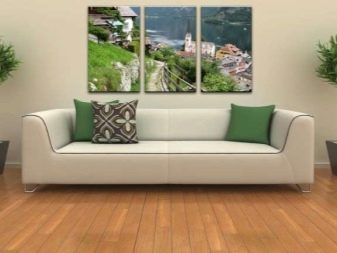

Let's take a closer look at each type of wall decorations.
- On a stretcher. Non-framed illustrations on canvas create the illusion of extra space. In fact, the parts of such a triptych are one whole picture, divided into three parts - with the correct placement of the pictures, the image smoothly flows from one canvas to another and visually expands the space. The disadvantage of such products is that they are not protected by a glass partition, therefore, over time, the surface may become covered with dust or get dirty.
However, paints such as oils and acrylics are well absorbed and adhere to the canvas, so the paintings can be gently wiped with a damp soft sponge without detergents.
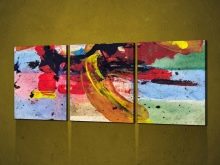


- Within the framework. Framed pictures are most often protected by glass, so the material for their creation can be not only oil or acrylic on canvas, but also watercolor on thick paper. Frames include both the classic version of the triptych with one general illustration, and different images made in the same theme and color scheme.



- Diamond embroidery. This type of triptych differs significantly from the previous two in that it is not made with paints - the picture is dotted with multi-colored acrylic rhinestones that create a beautiful image.


Popular topics
Currently, decorating your home with a triptych is not a difficult task, because there are a number of subjects that will suit any interior. We propose to consider a list of the most popular themes for modular paintings.
- Flowers. Paintings with flowers are a separate wonderful piece of art that will successfully fit into any interior. Bright poppies and roses will make a beautiful accent on the decoration of the guest room, dandelions will add lightness to the kitchen design, and delicate flowers such as lavender and orchid will envelop the bedroom with coziness and tranquility. Another popular version of the triptych with flowers is the Japanese sakura, which brings a touch of oriental flavor to the interior.



- Abstraction. Currently, interior paintings, which are abstractions, are very popular.
For office spaces, black and white, green and blue triptychs without accents are better suited, and for home you can choose both bright and pastel abstractions decorated with gold leaf.
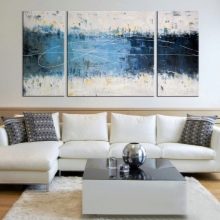


- Shapes. Geometric figures and silhouettes have been carrying a deep philosophical meaning for a long time, and artists often use this in their works, creating interesting ensembles of paintings.Illustrations with circles, lines, pyramids and other shapes, depending on the color scheme and style, are suitable both for a strict office setting and for a colorful apartment interior. As a plot, the masters choose not only various geometric shapes, but also silhouettes of people.
The most popular human silhouette theme is the figure of a ballerina or other dancer performing complex movements.



- Landscape. The image of nature is great for decorating a home, especially when the canvas depicts not only trees, but also a river or the sea, because such a picture creates a feeling of comfort and tranquility.
Landscapes can be changed depending on the season - this is a great option for those who like to change their home environment frequently.



- Town. Many people like to look at architecture - megalopolises, cozy Italian streets or the famous Eiffel Tower. Contemplating such places in reality is quite problematic, but you can decorate your house with a triptych with your favorite place and enjoy the view at any time of the day.
The composition of three paintings creates the feeling that the observer is really looking out the window, so such a work will definitely not get bored.


- Still life. To decorate the kitchen or dining room - a triptych with still lifes. It can be a classic image with fruits, vases and flowers, or a combination of still life and landscape. A bottle of wine, glasses and cheese against the backdrop of a green lawn or a picturesque waterfall create a comfortable environment at home, reminiscent of a spa vacation.

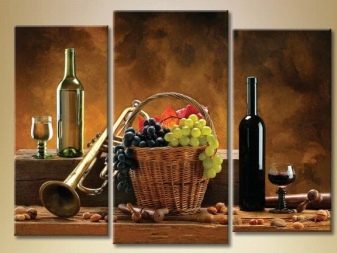
Nuances of choice
A triptych is a versatile interior decor, but in order for it to look appropriate, it is necessary to choose the right plot for each room. A well-chosen panel visually expands the space, emphasizes details and repeats the color scheme of the overall design. We propose to consider the criteria for choosing a composition of paintings for each separate room.

For kitchen
The best place to place an artistic ensemble in the kitchen is the space above the table or opposite the table when the seats at the table are turned towards the opposite wall. A suitable subject for the paintings is a still life with pastries, fruits or tea. Natural themes are also great for the kitchen - forest or seascape, flowers or a waterfall.
In nature, appetite is always much better than indoors, so the kitchen is often decorated with just such a plot.


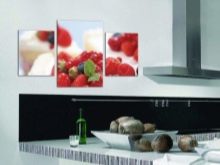
For bedroom
An important rule to follow when choosing a triptych for the bedroom is a soft, pastel color scheme and a calm plot. The room should have a peaceful environment that promotes relaxation and pleasant thoughts before bed. - it can be an image of a city at night, delicate flowers made in light colors, or abstract illustrations. It is best to place the composite canvas on the wall opposite the bed or on the wall on which there are no windows.
Sometimes the panels are hung over the bed - this is also a good option, but in this case it is impossible to look at the picture while relaxing.

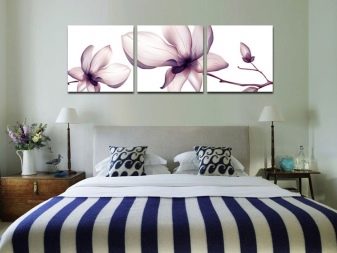
For the living room
The living room is that part of the house in which the owners can fully give free rein to their fantasies, because there are practically no restrictions in the choice of design and plot. The units are best placed where emphasis is needed, such as over a sofa, between large floor-standing flower pots, or close to a book or trophy rack.
The only rule for choosing a triptych for the living room is the correspondence of the theme and design of the paintings to the interior of the room.

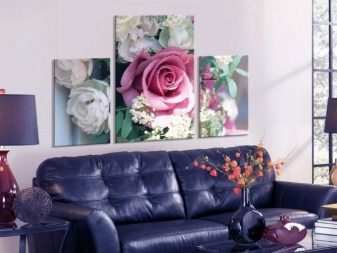
For children's room
When choosing decorations for a child's room, first of all, you need to rely on the age of the baby. For the room of a newborn and a child under 3 years old, it is better to choose soft abstract paintings made in pastel colors. School-age children already have preferences, so the plot of the picture should correspond to the child's hobbies - it can be a plot with cartoon characters, movies or comics, a world map, cars, models or football players. The taste of adolescents is still forming, so it is best for them to choose abstract paintings or images that match their hobbies or interests.


Accommodation options
You can hang a composite composition in two ways - with or without wall drilling. Each option is good in its own way, but it is suitable for different cases. Before fixing works of art on the wall, the owners need to consider the following nuances:
- the weight of the canvas together with the frame (if you are planning to install it);
- wall and decoration material;
- how long the triptych will stay in the selected location (temporarily or permanently).


We propose to consider a few tips on how to properly hang modular paintings.
- The most common way of attaching pictures is a serrated suspension. The universal bracket is screwed onto the subframe or artwork frame. To hang a panel with serrated hangers, you need to screw one nail into the wall for each canvas.
- For non-permanent fixing of pictures with a low weight, you can use special adhesive mounts - "chewing gum". Such a product is simply glued to the corners of the frame or stretcher, and then the canvas is pressed against the wall in the required place. Such a mount allows you to accurately calculate the distance between the paintings and their location relative to each other. The disadvantage of "gum" is that they cannot hold large jobs and require special conditions - in too humid rooms, for example, in the kitchen or in a room with a humidifier, Velcro will not last long.
Both vertical and horizontal modular compositions must be placed so that their lower edge is a few centimeters below the eye level of an adult - this is the optimal height for comfortable contemplation of the plot.
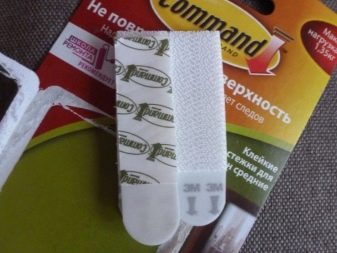

Famous paintings by artists
Many works, painted in oil several hundred years ago, have survived to this day. Most often these are paintings with a biblical plot, painted for churches and temples. We propose to consider several famous paintings that have significantly influenced the history of world art.
- "Annunciation". The painting was painted in 1333 by the Italian masters Simone Martini and Lippo Memmi. The triptych was created for the Siena Cathedral - it is part of a series of paintings with the patrons of the city. The Annunciation played a very important role in the development of the Gothic style of painting. To create the illustrations, the artists used a lot of varnish, gold and lapis lazuli to give expressiveness to the depicted patrons. The use of such materials gives the work a glowing effect, emphasizing the importance of the depicted subject.
Everything depicted in the picture carries a Christian subtext, down to the smallest details, for example, an olive branch in the hands of an angel is a symbol of peace, and lilies next to Mary are a symbol of purity.

- "Altar of Portinari". The triptych was created in 1475 by Hugo van der Goes, one of the most famous painters of the 15th century. An oil on wood artist wrote a traditional gospel story from the Bible - the worship of the shepherds. Hugo van der Goes used techniques new at that time in the production of modular images, which made a significant contribution to the development of Italian art of the early Renaissance.

- "Garden of Earthly Delights". The triptych The Garden of Earthly Delights, written in 1500-1510, is one of the most extraordinary creations of Hieronymus Bosch. The name of the picture, as well as its interpretation, are only hypotheses of art connoisseurs, because the author did not indicate either the name or the interpretation. The work got its name based on the theme of the central part, which depicts the sin of voluptuousness in various metaphorical and grotesque forms.The events of the modular picture smoothly change from left to right: in the first image, the artist showed how God presented Eve to Adam in paradise, in the central part earthly pleasures are depicted, and in the third module - the sad end of people who have surrendered to sin.
Such a smooth change of events is a classic technique of the artists of the time.

Examples in the interior
To successfully choose a triptych for rooms, you need to consider options for placement in the interior. Here are some examples.
- Living room. The Eiffel Tower is a very popular subject, but in this case, the author depicted this structure from an unexpected angle. The unusual perspective and viewing angle of the tower visually expand the space and create the feeling that you are really in Paris on the Champ de Mars.

- Bedroom. Delicate flowers to match the wallpaper, dark branches to match the headboard and white backdrop - this is a classic soothing shade for the bedroom.
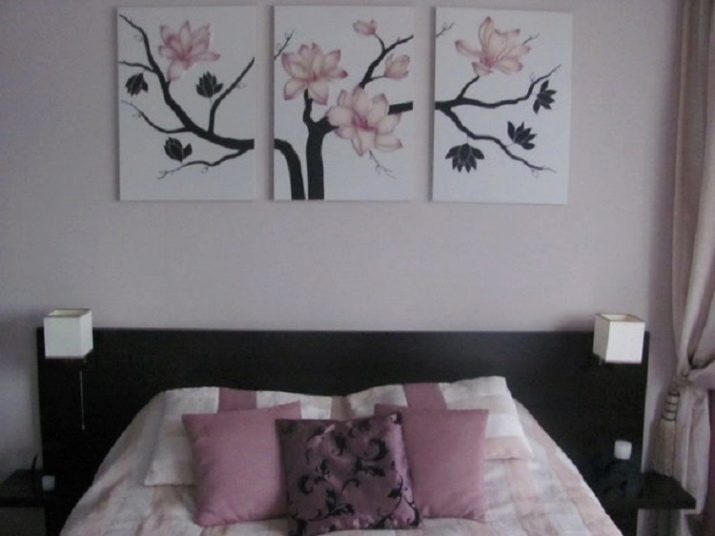
- Children's room. The best choice of a triptych for a nursery is animals made in pastel colors.

- Bedroom of a teenager. Vivid figures and silhouettes of characters from films or anime are the most popular composition of paintings for a teenager's room.

- Kitchen. An interesting option for the kitchen is a composition with chefs, such a plot will always awaken the appetite.

- Office. Calm black and white patterns are the best solution that will not distract people from the workflow.
